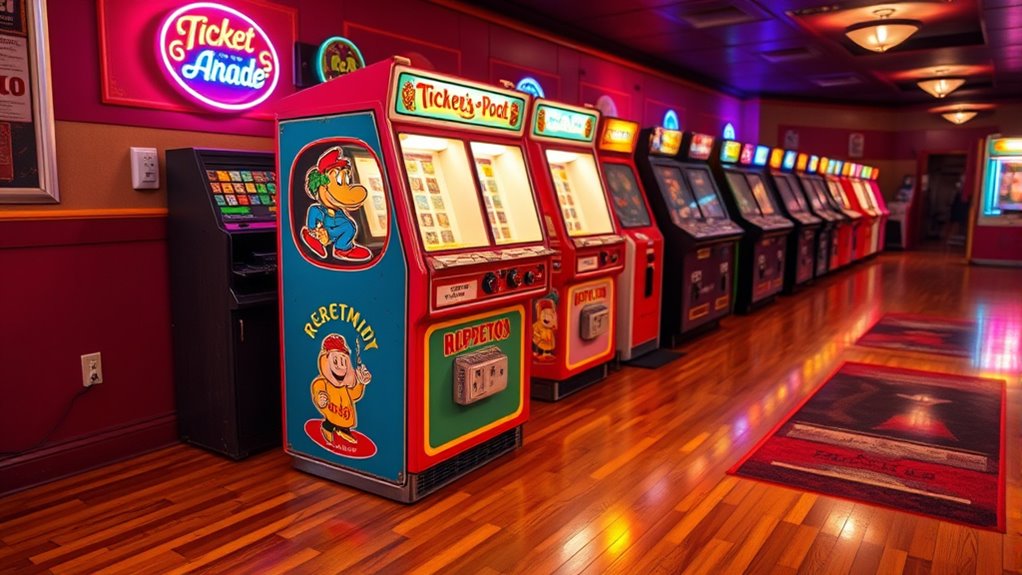Ticket redemption games started in the late 19th century as simple coin-operated machines designed to entertain and test players’ skill. Over time, innovations added ticket systems, prizes, and digital features, transforming arcade experiences. Today, you’ll find immersive visuals, advanced controls, and a variety of rewards that keep players hooked. If you keep exploring, you’ll discover how technology continues to shape these popular games and their cultural impact.
Key Takeaways
- Ticket systems were introduced to motivate players, encouraging repeat play and fostering loyalty through colorful tickets and prizes.
- Early ticket redemption games evolved from mechanical machines to electronic systems, improving reliability and efficiency.
- The integration of automated ticket vending and redemption kiosks streamlined prize distribution and enhanced arcade operations.
- Modern ticket games incorporate digital displays, immersive visuals, and interactive features to increase player engagement.
- Prizes expanded from simple items to high-tech gadgets, with themed and limited-edition rewards boosting excitement and community bonding.
Origins of Coin-Operated Games

Have you ever wondered how coin-operated games first came about? It all started in the late 19th century when inventors experimented with coin mechanisms to create self-service entertainment. Early machines used simple coin slots that triggered mechanical actions, making them easy to operate and maintain. As arcade design evolved, manufacturers focused on making machines more engaging and durable, which led to innovations like colorful cabinets and interactive controls. These advancements allowed games to attract more players and generate steady income. The integration of coin mechanisms became central to their success, transforming amusement from a social activity into a commercial enterprise. This foundation set the stage for the development of modern arcade games, including ticket redemption machines that continue to thrill players today. Additionally, the use of high-quality components like durable motors and precise mechanisms improved reliability and gameplay consistency.
The Rise of Skee-Ball and Early Skill Games

In the early 20th century, skill-based games like Skee-Ball gained popularity as a fun way to test your aim and precision. These arcade classics drew crowds with their simple yet challenging game design, making them a staple in amusement parks and arcades. Skee-Ball’s success inspired manufacturers to refine game mechanics, emphasizing player skill over chance. Its appeal lay in the satisfying combination of accuracy and strategy, encouraging players to improve their technique for higher scores and ticket payouts. As these early skill games grew in popularity, they laid the groundwork for future arcade games focused on player mastery. The engaging game design and competitive spirit of Skee-Ball helped establish skill-based games as a central part of the arcade experience. Additionally, the introduction of ticket redemption systems further enhanced player motivation and excitement.
The Emergence of Ticket Systems and Prizes

As skill-based arcade games like Skee-Ball became popular, operators looked for ways to keep players motivated and returning. They introduced ticket systems, where players earned tickets based on their scores, adding a tangible reward element. Ticket design became important, with colorful, eye-catching tickets that increased excitement and perceived value. These tickets could be accumulated and exchanged for prizes, which expanded in variety over time—from small trinkets to larger toys and electronics. The system created a direct link between effort and reward, encouraging repeated play. By offering a range of prizes, operators made the experience more appealing to all ages. This combination of engaging ticket design and diverse prize options helped establish ticket redemption games as a mainstay in arcades and family entertainment centers. Additionally, the concept of reward-based motivation played a significant role in maintaining player interest and fostering loyalty.
Technological Advancements in the 20th Century

The 20th century saw rapid technological advancements that revolutionized arcade games and ticket redemption systems. You experienced innovations like automated ticket vending, streamlining prize distribution. These changes also impacted arcade layout, allowing for more efficient space use and better player flow. As technology progressed, machines became more sophisticated, increasing engagement and efficiency. The introduction of electronic controls replaced mechanical parts, enhancing reliability. Ticket counters and redemption kiosks improved, reducing wait times. Here’s a snapshot of key developments:
| Innovation | Impact |
|---|---|
| Ticket Vending Machines | Faster ticket distribution, improved flow |
| Electronic Controls | Increased machine reliability |
| Modular Arcade Layout | Better space utilization |
| Automated Prize Dispensing | Reduced manual handling |
| Digital Scoreboards | Enhanced player experience |
– Additionally, the integration of ticket tracking systems allowed for better management of prizes and player data, further modernizing arcade operations.
The Development of Modern Interactive Machines

You’ll notice how modern interactive machines now feature vibrant digital displays that grab your attention. Touchscreen integration makes gameplay more intuitive and engaging, allowing for seamless control. Enhanced sound and visuals create an immersive experience that keeps players hooked and coming back for more. Additionally, educational design principles are increasingly incorporated to improve user experience and foster learning opportunities within these games.
Digital Display Technologies
Digital display technologies have revolutionized ticket redemption games by creating more engaging and interactive experiences. Digital signage allows for vibrant, dynamic visuals that draw players in and make gameplay more exciting. These displays can showcase real-time scores, animations, and personalized messages, heightening excitement and immersion. Augmented reality takes this further by blending virtual elements with the physical game environment, offering players a more immersive experience. With AR, players can see digital characters or effects overlaid onto the game, making gameplay feel more alive and enthralling. Additionally, integration with email marketing tools enables operators to tailor content and promotions to specific audiences, increasing engagement and repeat play. These innovations not only attract more players but also enable operators to update content easily, keeping games fresh and relevant. Overall, digital display technologies have markedly advanced the appeal and interactivity of modern ticket redemption games.
Touchscreen Integration Advances
Touchscreen integration has transformed ticket redemption games by making them more intuitive and engaging for players. Modern games now feature virtual interfaces that simulate physical buttons and controls, creating a seamless experience. These interfaces allow for quick, interactive gameplay, encouraging players to try new challenges. Haptic feedback enhances this experience by providing tactile responses when players touch or select options, making interactions feel more realistic. This technology also reduces the need for mechanical parts, increasing durability and reducing maintenance costs. Additionally, interactive technology has opened up new possibilities for game design, allowing developers to create more dynamic and customizable experiences. With these advances, games become more responsive and user-friendly, appealing to a broader audience. Overall, touchscreen integration has elevated ticket redemption games from simple machines to immersive, high-tech entertainment experiences that keep players coming back.
Enhanced Sound and Visuals
Enhanced sound and visuals have revolutionized modern ticket redemption machines by creating more immersive and enthralling experiences. You’ll notice how immersive audio heightens excitement, with dynamic sound effects that respond to game actions, keeping you engaged. LED lighting plays a vital role, illuminating the machine with vibrant colors and synchronized patterns that draw your attention. These visual enhancements make gameplay more engrossing, encouraging you to stay longer and try your luck again. The combination of crisp visuals and rich audio elevates the overall experience, transforming simple redemption games into interactive attractions. By immersing you in a multisensory environment, developers have successfully captured your interest and increased the appeal of these machines, setting a new standard for modern entertainment. Incorporating advanced sound design techniques allows for even more tailored audio effects that adapt to gameplay, enhancing the overall sensory impact.
The Influence of Video Games and Digital Integration

Video games have profoundly shaped the landscape of ticket redemption games, blending digital technology with traditional arcade attractions. You now find immersive experiences like virtual reality and augmented reality integrated into redemption games, enhancing player engagement. Virtual reality allows you to step into a fully digital environment, making the game more interactive and exciting. Augmented reality overlays digital images onto the real world, creating a seamless fusion of physical and virtual play. These innovations attract a new generation of players, boosting arcade attendance and increasing ticket redemption opportunities. Digital integration also enables easier tracking of scores and tickets, streamlining the redemption process. The incorporation of antioxidants into gaming experiences is also emerging, promoting health awareness among players. By harnessing cutting-edge technology, redemption games have evolved into more immersive, engaging experiences that appeal to tech-savvy audiences.
Trends in Prize Types and Incentives

As the popularity of ticket redemption games grows, so do the variety of prizes and incentives offered to players. Today, you’ll notice an expanding prize variety, from traditional stuffed animals and novelty items to high-tech gadgets and gift cards. This diversity aims to boost reward motivation, encouraging you to keep playing. Operators now emphasize appealing rewards that cater to different age groups and interests, making the experience more engaging. Limited-edition prizes and themed rewards are also common, creating excitement and a sense of exclusivity. These trends reflect an understanding that a broader range of prizes not only attracts more players but also enhances satisfaction and encourages repeat play. Additionally, offering a variety of incentives helps cater to individual preferences, making the games more inclusive. Ultimately, evolving prize options are key to keeping ticket redemption games fresh and appealing.
The Cultural Impact of Ticket Redemption Games

You’ve probably noticed how ticket redemption games bring people together through shared memories and experiences. They foster a sense of community and nostalgia that spans generations. Plus, they continue to shape youth entertainment trends, influencing how kids and teens engage with arcade culture today.
Nostalgia and Community
Ticket redemption games hold a special place in many people’s memories because they foster a sense of nostalgia and community. You might recall how these games sparked collectible trends, encouraging players to gather tickets for unique prizes and creating shared excitement. They became social hubs where friends and families bonded over friendly competitions and laughter. The thrill of winning tickets and exchanging tips nurtured lasting friendships and community spirit. These games also served as a common ground, bringing diverse groups together through shared experiences. Whether at arcades or fairs, ticket redemption games created moments that felt timeless, strengthening bonds and evoking fond memories. Their ability to unite people through simple fun keeps their cultural impact alive today.
Youth Entertainment Trends
Ticket redemption games continue to shape youth entertainment by adapting to current trends and technological advancements. They remain central to arcade culture, fueling youth engagement through innovative designs and interactive features. Today’s games incorporate digital screens, themed environments, and social sharing to attract new generations. This evolution keeps these games relevant, blending nostalgia with modern appeal. Below is a quick look at how these trends influence youth entertainment:
| Trend | Impact |
|---|---|
| Digital Integration | Enhances interactive experience |
| Themed Environments | Boosts immersion and appeal |
| Social Sharing | Promotes community and competition |
| Mobile Compatibility | Extends engagement beyond arcades |
| Customization Options | Increases player personalization |
These trends sustain youth engagement and embed ticket redemption games into contemporary arcade culture.
Future Directions and Innovations in Play

As technology continues to evolve, the future of ticket redemption games is poised to become more immersive and engaging. Expect augmented reality to transform gameplay, blending digital overlays with the real world to create interactive challenges that enchant players of all ages. Virtual experiences will also play a larger role, offering entirely digital environments where players can compete, earn tickets, and reveal rewards without physical constraints. These innovations will make games more dynamic, personalized, and accessible, encouraging longer play sessions and increased excitement. As manufacturers incorporate advanced sensors and real-time feedback, you’ll find yourself more immersed in a seamless blend of physical and digital play. This evolution promises to redefine the arcade experience, making it more captivating and future-proof.
Frequently Asked Questions
How Did Ticket Redemption Games Evolve Internationally?
You see, ticket redemption games evolved internationally by adapting to different markets’ needs and regulations. Game designers improved ticket design to attract players and comply with international arcade laws, ensuring fairness and safety. As a result, these games became more sophisticated, offering diverse gameplay experiences worldwide. You can notice how these changes made the games more appealing and accessible across various countries, fueling their global popularity and continuous innovation.
What Safety Regulations Govern Modern Ticket Machines?
Imagine your ticket machine as a guardian on a busy street, carefully watching over safety. Modern ticket machine safety relies on strict regulatory standards that guarantee electrical safety, user protection, and reliable operation. These standards govern everything from wiring to accessibility features, preventing accidents and ensuring smooth gameplay. By adhering to these guidelines, manufacturers build trustworthy machines, giving you peace of mind as you enjoy your experience without worry.
How Do Ticket Systems Impact Arcade Business Profitability?
You see, ticket systems directly influence your arcade’s profitability through prize distribution and revenue models. Efficient ticket systems attract more players by offering appealing prizes, increasing game play and ticket sales. Smart prize distribution encourages repeat visits, boosting revenue. By optimizing your ticket system, you maximize your revenue streams and enhance customer satisfaction, ultimately making your arcade more profitable and competitive in a busy entertainment market.
Are There Environmental Concerns Linked to Ticket Prize Production?
You should consider the environmental concerns linked to ticket prize production, especially regarding electronic waste management and the use of eco-friendly materials. Many manufacturers are now adopting sustainable practices to reduce waste and use recycled or biodegradable materials. By choosing eco-friendly prizes and supporting responsible disposal, you help minimize environmental impact and promote more sustainable arcade practices, benefiting both the planet and your customers.
How Do Ticket Redemption Games Influence Childhood Development?
You see ticket redemption games shaping childhood by boosting cognitive benefits and fostering social interactions. These games challenge your problem-solving skills, improve hand-eye coordination, and encourage strategic thinking. At the same time, they promote friendships, teamwork, and shared excitement. As you play, you learn patience and sportsmanship, while making memories with friends. These experiences help develop well-rounded skills, blending fun with essential social and cognitive growth.
Conclusion
As you step into the vibrant glow of a modern arcade, you see the evolution unfold before your eyes—bright lights flicker on classic machines, digital screens pulse with new possibilities, and tickets cascade like a shower of dreams. This history of ticket redemption games is a story of innovation and nostalgia, inviting you to imagine the endless ways technology will shape your next adventure. The future’s just waiting to be played, with excitement shining brighter than ever.









